We’ve been eating a lot of fermented vegetables lately. We started with kimchi (Homemade Kimchi, Jun 26, 2011), but lately we’ve been fermenting our vegetables in a less spicy style that is normally used for sauerkraut.
“Sauerkraut” means “sour cabbage.” We are not huge cabbage fans, so we often substitute other vegetables. We’ve had good results from Daikon radish, red radish, carrot, celery, and cabbage; the only vegetable we didn’t care for was parsnip.
This is a really simple procedure – mix salt, water, and vegetables with a few spices; leave in a cool, dark sealed container for 7-10 days; eat.
For safety, the key is to give enough time for the water to become acidic. Wikipedia explains the evolution of the bacterial population:
The fermentation process has three phases. In the first phase, anaerobic bacteria such as Klebsiella and Enterobacter lead the fermentation, and begin producing an acidic environment that favours later bacteria. The second phase starts as the acid levels become too high for many bacteria, and Leuconostoc mesenteroides and other Leuconostoc spp. take dominance. In the third phase, various Lactobacillus species, including L. brevis and L. plantarum, ferment any remaining sugars, further lowering the pH. There are unpasteurized sauerkrauts on the market. Properly cured sauerkraut is sufficiently acidic to prevent a favorable environment for the growth of Clostridium botulinum, the toxins of which cause botulism.
Klebsiella and Enterobacter are potentially pathogenic bacteria, but the later Leuconostoc and Lactobacillus species are probiotic. So the more acidic the water, the better the mix of bacteria.
Another good tactic is use predominantly low-calorie vegetables. Keeping sugar levels low will help keep the yeast population down.
First Batch: Daikon radish, celery, carrot
Here were the raw materials for one batch:
We could have cut the white Daikon radish pieces smaller, but this size did fine: by day 7 they were softened all the way through.
Sea salt, ginger, garlic, and peppercorn are seasonings we consider essential; green onion and red pepper have worked for us as well.
You’ll need a large glass or ceramic container that seals. If it is glass, keep it in a dark cabinet while fermenting to avoid light exposure. We like to look at ours in progress, so we bought glass containers.
Fill the glass container about 80% full with diced vegetables, then cover with water so the container is 90% full. Add enough sea salt that the water tastes salty, but not undrinkably so. Also add the other seasonings – ginger, garlic, peppercorn, and any others you choose.
The container will now look like this:
Now it has to be covered with an air-tight seal. We placed plastic wrap over the top, wrapped a rubber band around the jar, and then sealed the lid over the wrap:
After a week it will look like this:
Note how cloudy the water has become.
After a week you should be able to start removing vegetables to eat. Here are some vegetables:
It’s also a good idea to remove the cloudy fluid and drink it. This makes a great “soup” or beverage along with your meal.
As you remove fluid, add water and sea salt to replace what you took. When you run out of vegetables, add a new batch of diced vegetables to the old fluid and let it ferment for a week.
Second Batch: Daikon radish, green onion, and red radish
This first try was so successful we bought a larger glass container and made another batch, this time including red radish. Ingredients:
Here it is ready to go into a dark cabinet for fermentation:
And here it is a week later:
All the red skin pigment has come off the radishes and into the fluid. Here is a bowl of vegetables and fluid:
We’ve been eating two bowls a day, one at dinner and the other at breakfast or lunch.
Other Tips
Try to keep the fermentation jar sterile. We replace the wrap every time we open the container, and keep the lid region dry at all times: if any fluid spills on it as we take vegetables out, we dry the top of the jar with a paper towel. (Bacteria need moisture to thrive.)
If you have concerns about the bacteria on your vegetables, sprinkle salt over them and let them sit for a bit, then rinse the vegetables before dicing them and adding them to the container. This salting will help sterilize the surface a bit.
Conclusion
Even if you don’t like vegetables, you’ll probably like this. Fermented vegetables are surprisingly tasty. Moreover, the fluid is also very tasty. It makes a healthful hydrating beverage, and a great accompaniment to a meal; the acidic fluid helps clear the palate and improve the taste of foods.
We couldn’t be happier with our vegetable fermentation. It makes vegetables taste great, provides us with helpful probiotic flora and lactic acid, and is exceptionally easy to prepare. No cooking necessary!









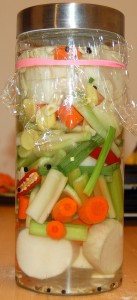
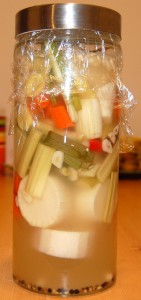
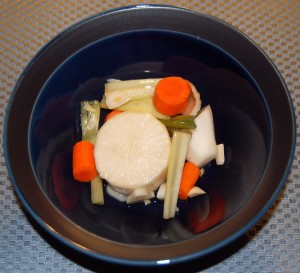
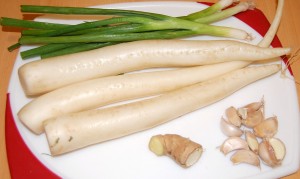
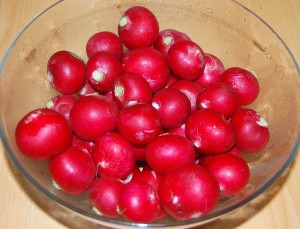
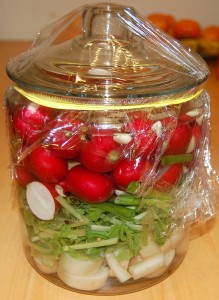
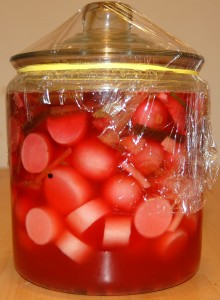
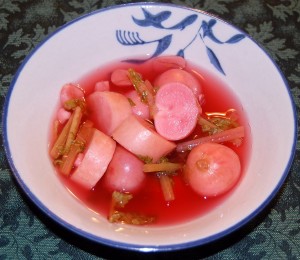




Hi Paul,
I’m surprised that you suggest using plastic wrap inside the lid to seal the jar.
I always have some overflow of brine when fermenting, meaning that the corrosive liquid would remain in contact with the plastic wrap for some time. Isn’t it dangerous to have even ‘ffod grade’ plastic wrap in contact with highly acidic foods ?
Thanks for your website.
Hi Andrew,
With our big jar we put the plastic wrap outside. The reason we put it inside on the other container was that that had a metal lid, and we didn’t want the acid to leach metals. I suppose you have to decide which is more dangerous, metal or plastic.
We haven’t yet had the brine reach the wrap. If it were going to be in contact then I would try to find a container that was all glass or ceramic.
Best, Paul
Ellen, thanks so much for the pickl-it link! They look like just the thing for the newbie … am definitely going to try them out.
Galina L, I am confused, why did you recommend to use salt with iodine if iodine inhibits fermentation? I thought the whole idea is to ferment the vegetables?
Paul, I tried fermenting for the first time with cabbage years ago and the bubbles that were on the cabbage were all grayish looking. I was afraid it eat it, so threw it out. What did I do wrong?
Hi Kathy,
I don’t know what would have a grayish surface film. Possibly impurities in the water? We use a Britta filter to clean the water.
When food goes bad, you often get a scummy-cloudy film from bacterial waste. High temperatures, not enough salt, starting with an unclean container, too much sugar in the mix are all things that could contribute to growth of inappropriate bacteria.
Anyone want to chime in?
I have a canning jar with a metal band but no lid. I threw together a quick batch of veggies a few days ago using a layer of plastic wrap, with a layer of tin foil and another layer of wrap on top of that as my lid, I then tightened it down with the band and threw a rubber band around the whole deal for good measure.
My closet now smells like the fermenting vegetables, wondering if it will be safe to eat.
Andrew, words, literally, to live by: When in doubt, throw it out.
Hmmm. How much air space was there? Did the liquid overflow? Even a tiny bit. That may be why your closet smells like fermented veg ( as opposed to rotten veg, which I would definitely throw out)
I had a recent similar episode in my spare fridge where I store my ferments. That taught me that some vegetables just produce more liquid than others, and I do need to leave space and to check up on the liquid levels. Each batch is a little different it seems.
Doesn’t look like it overflowed at all. My concern is if I can smell it, that means that the seal isn’t air tight.
Hi Paul,
Does this mean that the sauerkraut, what i buy which was fermented, for 6 weeks and then heated for 5 min. at 175f is not good?
Thanks
Hi Andrew,
If the seal was reasonably tight, then there would have been a slight overpressure in the jar and gas would escape but oxygen wouldn’t go in. So everything might be fine.
We get a slight odor, not strong, but the nose is very sensitive so it doesn’t take much even with a good seal.
I would say taste it. Usually if it’s good it has a pleasant taste; if it’s gone bad there’s a sour, unpleasant taste.
Hi Herb,
It is probably good, it will have many beneficial nutrients and acids from the fermentation, but the heating may have killed most of the bacteria. Sort of a mild pasteurization. With commercial production methods, which aren’t very antiseptic, this kind of pasteurization is probably necessary for healthfulness, or to extend shelf life.
Just popped the top off and tried some daikon and green onion, they were fantastic. No mold, slime or unpleasant flavors.
Thanks Paul, I don’t think I would have tried this had you not demonstrated just how simple the process is. Now the girlfriend is hooked, though she isn’t a huge fan of the closet smelling.
Andrew,
Do you have a cooler? Or even just a cardboard box?
I was wondering if anyone knew what to do to prevent mold growing =)
*Assuming the lid comes off several times during the fermentation process (some people in my family just can’t wait all 7 days)
Hi Jason,
1. Start from a completely sterile container.
2. Don’t use any moldy or old vegetables.
3. Salt the vegetables for a while, then rinse the salt off at the last moment before putting them in the container.
4. Use more salt in your brine.
5. Avoid sugary vegetables.
Have you actually had a mold problem, or are you just worried? If you eat them quickly enough there shouldn’t be a problem.
Well I filled a 2 gallon container with vegetables, water, and salt. Waited 7 days and opened it up (apparently not the first time because certain people couldn’t wait the full duration) and found mold on the top….. Not sure if what I did next was very prudent but I couldn’t waste all those veggies. So i just scooped off the top layer (and then some) and ate the rest. I figured the salt and acidic environment of the water would prevent whatever was engrossed in it from housing that same mold.
Using brother’s computer so name comes up as Michael instead of Jason*
Hi Jason,
Well, we had that happen only once – when we tried fermenting cucumbers. We discarded the whole thing. Other than that one instance, we’ve been mold free.
When it comes to mold, I’m in the better safe than sorry camp, with erp.
funny coincidence with the cucumbers…..wonder what it is about them
Hi Jason and Paul,
When my dad ferments cucumbers, he always does it with the lid open and the jar up on the kitchen counter (no dark cabinet). They’ve always turned out fine.
I make quite a few kinds of pickles (great way to preserve excess food). Girlfriend and I just started PHDing after I attended the talk at crossfitnyc and I’ve been excitedly exploring the site.
A few pickling tips gleaned from experience:
Keep the temperature in the range of 65-75F for a 7 day ferment. Lower temps support longer fermentation times (sauerkraut is often made during cool times of the year and can take up to six weeks under these conditions). Higher temps favor the growth of yeasts and molds and are not recommended.
If you like crisp veggies then a couple fresh tannin-rich leaves (eg. oak, grape) added to each quart size jar prior to fermenting will keep them from getting mushy.
As far as I know that greyish film is yeast. If you can tolerate yeasts then just pour off that top layer (most should go off with the liquid and you can also discard the top layer of veg). The rest underneath should be just fine.
Red cabbage kraut will appear more visibly red when finished (remember the cabbage indicator experiment from grade school?)
Enjoy and have fun experimenting!
Just made a batch of carrots and celery. Super tasty! The bottle fizzed when I opened it, which was kind of neat. 🙂
Making fermented jalapenos now!
Just opened my first jar after 1 week. VERY fizzy! Overflowed a bit with bubbles. It’s funny, because I’ve experimented with making ginger beer before with not much success and now without even trying, I made ‘vegetable’ beer! Pleasant surprise.
How do they taste, Rick?
I made my first jar last week: radishes, asparagus, purple cauliflower, carrots, celery, cabbage, garlic, ginger. Everything worked beautifully and they taste fantastic.
Just one issue: since I started eating them, my intestines have been crunching and churning and noise-making. Along with that is a lot of, well, gas.
This is the first time I’ve eaten fermented veggies, and I’ve been on a Paleo diet for a couple of months.
Anyone else have a similar experience?
Yes.
I just started making homemade kefir soda – both with kefir grains and probiotic capsules.
Overconsumption at first led to some intestinal issues, but I seem to be acclimating and I love the flavor.
Is it ok to open the jar in the middle of fermenting and then close it and let it ferment some more? Anyone?
Thanks!!
Well, we do that when taking vegetables out to eat. I don’t think it’s a big deal as long as it’s not open too much.
I use just plain glass jar for fermenting my veggies, but make sure everything is covered with brine. If you worry about some mold, place your fermenting jar after opening into refrigerator. It will not stop fermenting but decrease the possibility of
mold (just my personal experience)
Some things i read about making Sauerkraut (which i love) The “old” process included a “plate”(made of wood) and a rock or other weight to keep the kraut under the brine. the top became “moldy” but is not a bad kind. In some places its called “bloom” it can be scraped off gently and discarded.
I have on hand 2 crocks with lids. the lids fit in a built in trough. water in this trough is the “seal” the lids have 2 little notches in the edge. When the pressure of the fermentation gases is enough, it bubbles out. a little “plop” sound you hear every once in a while…several times an hour when its going good. The crocks came with little clay “stones’ to hold the kraut beneath the brine.
this sealing process can be produced by using a wine making stopper (2 to 3 $ in a wine making store) this is all the seal you need to keep oxygen out.
bear in mind that each time you open the batch, new oxygen is introduced. but if the fermentation is continuing, don’t worry about it. I hope this helps others to have confidence in trying the fermentation process. I want to try fermenting some local plums.
thank you for the good information.
Anyone tried beetroot, or is it too sugary? It is in sandor Katzes book.
I like them so much I can’t wait to ferment them. Maybe it’s worth a try though. We usually do mixed vegetables, so a beet won’t add much sugar.
Hi Paul,
I’ll precede my question by saying I have ulcerative colitis and I’m having great difficulty with experimenting with what to eat because of the severity of my symptoms (which includes daily blood along with diarrhea)(I am under a dr’s care BTW). I don’t seem to be digesting veggies well, so fermented veggies sound like the way to go.
I made an incredibly delicious and very beautiful looking batch of fermented veggies but I had ‘trouble’ within 3/4 of an hour after consuming a few pieces of the veggies. The next day I tried just a slice of carrot and a half of a radish. Same result. I’m worried (with good reason) about triggering a flare of my UC, but Ithink I need to find a way to consume sufficient plant food. Do you know if a ‘dysbiosed’ gut just needs time to get used to the introduction of fermented veggies and that maybe I should just risk an increase in symptoms and hope I acclimatize? I had worked up to about 2-3 Tblsp of Bubbies sauerkraut per meal (successfully – meaning no increase in symptoms, but also no improvement) before I tried my own fermented veggies.
Does the fact that the fermented veggies caused almost immediate symptoms indicate a problem elsewhere (not just in the colon)? When I eat fresh veggies (well cooked) they mostly come out undigested, except, oddly enough, small amounts of lettuce Am I on the right track to try some digestive enzymes before I eat?
Hi HM,
It certainly sounds like you must have a problem in the stomach and small bowel or pancreas in order to have such difficulty digesting food. I would be sure to chew everything thoroughly, each bite to a liquid mush, before swallowing; and you might want to experiment with digestive aids like betaine hydrochloride (for stomach acid) and pancreatic enzymes. Also, you might look into whether your bile duct (possibly after the merger with the pancreatic duct so that pancreatic enzymes are blocked) is blocked by gallstones. If so, there may be gallstone cleanses or something else you can do. Citric acid from lemon juice may help.
The negative reaction to the fermented veggies could be either from undigested food, or from new bacterial species either competing with your pathogens or, via a leaky gut, increasing immune activity. In general the fermented vegetables should compete with and help displace bad bacteria in the long run, but you want to minimize the short run negative effects. If you can improve digestion, that would help everything.
So I would ask your doctor to look into why your upper digestive tract seems not to be working properly.
Best, Paul
Do people scrub their vegetables and clean them well or will that remove the beneficial bacteria ?
It will remove bacteria. I think rinsing them is good enough.
Himalayan salt should work also?
Yes.
Learning so much from your site! Thank you!
Do you have any concerns about lactic acid? I know that Ray Peat recommends avoiding due to its associations with fibrosis. It’s also the “waste” of cancer cells.
Would love your thoughts!
Hi Eve,
The general thinking is that lactic acid producing bacteria are highly beneficial for the human digestive tract. See eg http://www.ncbi.nlm.nih.gov/pubmed/21162695.
If it’s good to have lactic acid produced in the gut, then it should be OK to eat it.
The body metabolizes lactic acid quite well. It seems unlikely moderate food doses would be harmful.
Thanks Paul 😛
Hi Paul!
What’s your take on kombucha? It sounds really interesting. Have you tried it? Maybe brewed it yourself?
Hi Sakari,
I haven’t made it myself, but I do buy it every once in a while at Whole Foods.
Hi Paul!
I find that when using your method, some vegetables float to the top and can get soggy. The brine still tastes sour(and delicious!). Does sogginess mean mold? what would you recommend in this case?
I don’t know what sogginess means. I would think if there wasn’t much air in the container and if you can’t see any visible mold, they should be safe to eat.
With thanks! It is definitely an astonishing web site.
What do you think of kombucha and similar drinks for gut bacteria balance?
Good Day Paul–
Regarding fermenting vegetables; My wife has been fermenting vegetables in the fridge using cider vinegar & water with spices. Is this acceptable and does this method maintain all the benefits of eating veggies and restoring/maintaining gut health? Thanks!
I had read about putting the veggies in a mason jar and then pouring coconut oil over the top. It hardens and prevents the veggies from coming above the brine. And, as the veggies ferment, gas is able to escape around the corners of the hardened oil and my jars have been overflowing quite regularly. I never read that anything has to be airtight, just that the veggies can’t come above the brine.
So how do you eat these fermented veges, do you heat them up or eat them cold ???
We eat them cold
Heating them would destroy all the good bacteria, which is why you are fermenting them in the first place!
Hi,
I have opened my first batch after about a week. It has a sharp sour vinegar taste. I am not sure what it is supposed to taste like but I did not find it pleasant at all just wondering if it may have gone bad.
Hi George,
It is supposed to be sour, if it is acidic then it is probably good. The main acid is lactic acid from Lactobacillus and Leuconostoc type bacteria, see https://www.facebook.com/groups/476375132470281/552751218166005/.
It is an acquired taste, try just small quantities on meat and potatoes as a flavoring agent/spice. You can store the fermented vegetables in the refrigerator in a sealed container and they’ll remain good for 3-4 weeks.
❓ If you heat the fermented vegetables or use the liquid in soup, won’t the heat kill the beneficial bacteria? In which case, what’s the point? Also, what’s your opinion of using a starter culture?
What’s your take on kombucha versus candida? Do you think it helps against it or exacerbates the issue? I’ve heard so many mixed comments about that.
Hi, I made sauerkraut this week and it tastes very good – i opened today, thank you for your information. I was wondering, do you refrigerate the vegetables after you have opened the jar. Thanks Leanne